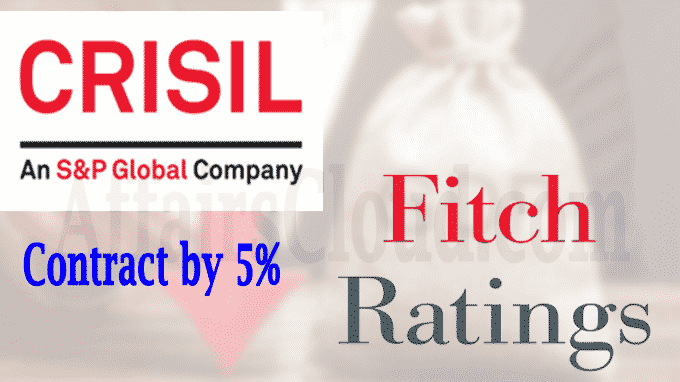 Fitch’s GEO
Fitch’s GEO
On May 27, 2020 According to Fitch’s Global Economic Outlook(GEO) for May, India’s Gross Domestic Product(GDP) is anticipated to a 5% decline in the current financial year(ending March 2021) from its earlier forecast(late-April’s GEO) of growth of 0.8% due to the pandemic economic activities.This is the biggest forecast cut to India.
Reasons leading to growth contraction: The growth contraction in the current fiscal is mainly due to a 8.3% and 9.7% contraction in consumer spending and fixed investment in FY21.
Forecasts:
i.Fitch predicted 2 consecutive quarters of contraction or negative year-on-year growth in current fiscal (-)2.7% in April-June and (-)12.4% in July-September alternatively comparing to 1.2% estimated growth in January-March.
ii.The growth is expected to rebound to 9.5% in 2021-22. In the previous fiscal the growth was estimated at 3.9%.
Global Projections:
World GDP & Emerging Markets(EM)- The global GDP is forecasted to fall by 4.6% in 2020 from its earlier prediction of 3.9%. The output in EM China to fall by 4.5% this year compared to a predicted fall of 1.9% before.
Eurozone GDP– The GDP of the eurozone is expected to fall by 8.2% in 2020 compared to a contraction of 7.0%. The GDP of Spain to fall by 9.6% (previously: -7.5% ), by 9.5% in Italy (previously: -8.0%) and by 9.0% in France (previously: -7.0%) in 2020.
Technical Pickup
- Fitch foresees a technical pick-up in global GDP to 5.1% in 2021 with United States(US) and eurozone output rising by around 4%, but pre-virus levels of GDP will remain in the United States until mid-2022.
- Significantly later in Europe UK, Brazil; Russia’s GDP- The United Kingdom (UK’s) GDP is expected to contract by 7.8% this year (compared to -6.3% before). Brazil and Russia will see a GDP falling by 6% (revised from -4%) and 5% (previously: -3.3%) this year respectively.
Unchanged GDP
The 2020 GDP growth for China, the US and Japan unchanged since late April at 0.7%, (-)5.6 % and (-)5% respectively.
Fiscal Deficit
Fitch expects China’s general government fiscal deficit to widen to 11.2 % in 2020 from 4.9 %in 2019as. The US has announced an additional fiscal package at more than 2% of its GDP.
Quantitative Easing(QE)- The agency predicts that QE will reach USD 6 trillion in 2020, which is equal to half of the cumulative QE purchased by the Fed, European Central Bank(ECB), Bank of England and Bank of Japan combined in 2009-2018.
Downside scenario- In case of a downside scenario, GDP will fall by 12% in the US and Europe in 2020 and global GDP will drop by more than 9%.
Note: The rating agency has warned that the aggressive comeback of coronavirus that necessitates extended or renewed nationwide lockdown will lead to an even worse outcome.
Other sectors affected:
The collapse of the labor market with US unemployment is now expected to rise to 20 % in May and the current social distance will weigh heavily on consumer spending post-crisis, while companies will be more wary of capital spending.
What is QE?
It is a form of unconventional monetary policy in which a central bank purchases long-term securities from the open market to increase money supply and stimulate lending and investment.
CRISIL
The latest report by CRISIL predicted that the gross domestic product (GDP) of Indian economy will contract by 5% in fiscal 2021. This estimate followed the April 28, 2020 forecast of 1.8% growth, from its earlier forecast of 3.5% growth.
Reason : The key reasons behind this decrease are extension in lockdown, higher economic costs and an economic package.The report also stated that current quarter GDP i.e. Q1FY21 to shrink 25% on-year.
Forecasts:
Crisil also forecasted a 10% permanent loss to real GDP over the next three years as it is not possible for Indian economy to move back up to the pre-crisis trend level of GDP.
- This permanent loss is defined as the gap between the likely level of GDP which would have been achieved at pre-Covid growth trends and post-Covid growth trends.
The assumption for this estimate is average growth of about 7% between fiscals 2022 and 2024.
Note: The Indian economy is facing its fourth recession since independence, which may also be its worst. India has faced a recession thrice in the past 69 years viz. in 1958, 1966 and 1980.
Other affected sectors
i.Recessions were due to the monsoon that hit agriculture. But now, the pandemic-induced lockdowns have affected most non-agriculture sectors.
ii.The pandemic global impact has affected India’s export front.
About CRISIL:
Headquarters– Mumbai
Managing Director and Chief Executive Officer (CEO)– Ashu Suyash
Other agencies:
i.According to the State Bank of India’s (SBI) Ecowrap report, GDP growth is likely to be 4.2% for FY20 and contract 6.8% in FY21.
For more details visit a previously posted article https://affairscloud.com/indias-gdp-growth-is-expected-to-reach-1-2-in-q4-fy20-sbi-ecowrap-report/
ii.India’s GDP prediction by Goldman Sachs
The American brokerage expects the Indian economy to contract by 5% in FY21, the worst performance by the country ever. The GDP will contract by 45% in the June quarter as compared to the January-March period on an annualized basis due to the continuing lockdown.
About Fitch Ratings:
Headquarters– New York, US
President– Ian Linnell
For more details visit a previously posted article – https://affairscloud.com/indian-economy-to-contract-5-in-fy21-goldman-sachs/




